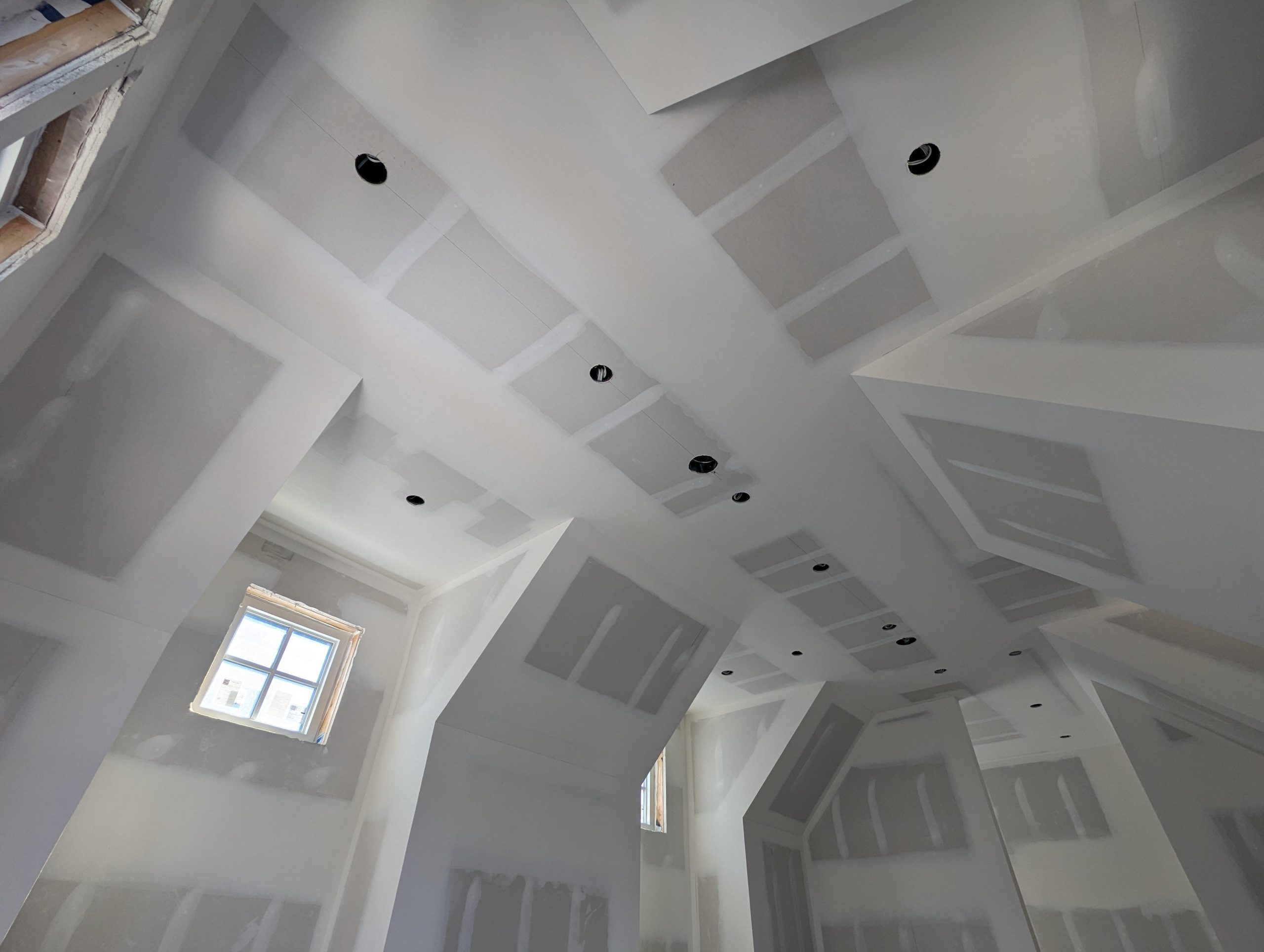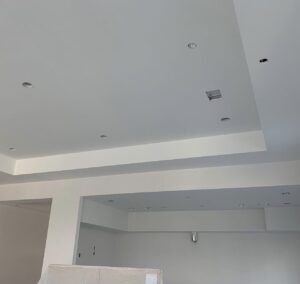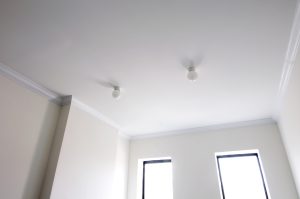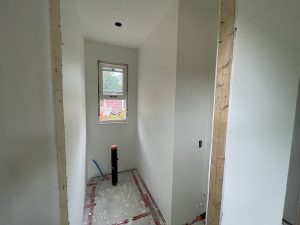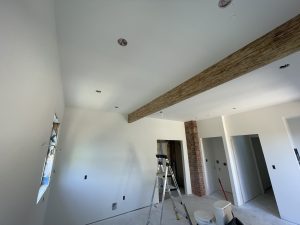When it comes to drywall finishing, moving beyond the basics can transform a space from ordinary to extraordinary. In this in-depth exploration of advanced drywall finishing techniques, we’ll delve into the intricacies of achieving a professional and polished look that goes beyond the standard taping and mudding. Whether you’re a seasoned DIY enthusiast or a professional contractor, these techniques are sure to elevate your drywall finishing game.
1. Layered Finishes: Adding Depth and Dimension
The art of layered finishes involves going beyond the conventional single-layer approach. By experimenting with different types of joint compounds and applying multiple layers with varying thicknesses, you can create a sense of depth and dimension on your walls. This technique is particularly effective for accent walls or areas where you want to draw attention.
Begin by selecting a base layer that serves as the foundation for your finish. Apply subsequent layers with varying thicknesses, using different joint compounds for each layer. This not only adds visual interest but also allows for creative exploration in terms of texture and appearance.
2. Artistic Texturing: Beyond the Basics
While basic texturing techniques like skip trowel or stomp brush can add character to drywall, advanced artistic texturing takes it a step further. Explore unconventional texturing methods to create unique finishes that stand out. Consider incorporating hand-crafted textures or experimenting with tools to achieve one-of-a-kind patterns.
Think of your drywall as a canvas, and the joint compound as your paint. With artistic texturing, you can create visually stunning effects that mimic the look of natural materials or add an artistic flair to any room.
3. Faux Finishes with Joint Compound: Mimicking Elegance
One of the most exciting aspects of advanced drywall finishing is the ability to mimic the appearance of other materials. Using joint compound, you can create faux finishes that imitate the look of stone, brick, or even wood. This technique is an excellent way to add a touch of elegance to any space without the cost and weight associated with these materials.
To achieve realistic faux finishes, start by selecting the material you want to mimic. Then, apply the joint compound in layers, using tools to create the desired texture. Once dry, paint the surface with the appropriate colors to enhance the resemblance.
4. Seamless Corner Finishing: Crisp and Clean Lines
Achieving seamless corners is an advanced technique that requires precision and attention to detail. Inside and outside corners can be challenging areas to finish without visible seams, but mastering this skill adds a level of professionalism to your work. Properly finished corners contribute to the overall aesthetic appeal of a room.
To achieve seamless corners, start by using a high-quality corner bead. Apply joint compound evenly, feathering the edges to create a smooth transition. Sand carefully to ensure the corners are flush and free from imperfections. This technique requires practice, but the results are well worth the effort.
5. Custom Stenciling and Designs: Personalized Accents
Take drywall finishing to an artistic level by incorporating stencils and custom designs. This technique allows you to add personalized accents to walls, turning them into unique works of art. Whether you’re creating a subtle pattern or an intricate design, stenciling offers endless possibilities for customization.
Begin by selecting a stencil or designing your own. Secure the stencil to the wall and apply joint compound evenly to create the desired pattern. Once dry, you can leave it as is or enhance it with paint for a stunning effect. Custom stenciling is an excellent way to add character to feature walls or focal points in a room.
6. High-Gloss Finishes: Modern Sophistication
For a modern and sophisticated look, consider achieving a high-gloss finish on your drywall. While this technique requires careful execution, the results are worth it. High-gloss finishes not only add a luxurious touch to your walls but also make them easier to clean, contributing to their longevity.
Start by selecting a high-quality, moisture-resistant joint compound. Apply it evenly and sand the surface meticulously to achieve a smooth finish. When it comes to painting, choose a high-gloss paint and apply it in thin, even coats. The reflective nature of high-gloss finishes can make a small space appear larger and bring a contemporary feel to any room.
7. Invisible Repairs: Concealing Imperfections
Every seasoned DIYer or contractor encounters the challenge of repairing damaged areas without leaving visible traces. Advanced techniques for invisible repairs involve seamlessly blending repaired sections with the surrounding finished drywall. Whether it’s scratches, gouges, or other imperfections, the goal is to make the repair virtually undetectable.
To achieve invisible repairs, start by carefully removing any loose or damaged material. Use a high-quality joint compound to fill and smooth the damaged area, feathering the edges to blend with the existing finish. Sand meticulously to achieve a seamless transition. The key is to take your time and pay close attention to detail during each step of the repair process.
8. Metallic and Iridescent Finishes: Unique Elegance
Incorporating metallic or iridescent finishes into your drywall adds a touch of unique elegance. While these finishes may seem intimidating, with the right techniques, you can create walls that shimmer and shine, transforming the ambiance of a room.
Choose specialty joint compounds formulated with metallic or iridescent properties. Apply them evenly, allowing the compound to catch and reflect light. When it comes to painting, select colors that complement the metallic or iridescent effects. This technique works exceptionally well in spaces where you want to create a sense of luxury and sophistication.
9. Polishing and Buffing Techniques: The Art of Refinement
Taking drywall finishing to the next level involves polishing and buffing the surfaces to achieve a smooth and reflective finish reminiscent of polished plaster. While this technique requires patience and precision, the result is a wall that exudes refinement.
After applying joint compound and allowing it to dry, sand the surface meticulously to remove any imperfections. Follow this with the application of a high-quality primer. Once the primer is dry, use a fine-grit sandpaper to achieve a polished finish. The final step involves buffing the surface with a soft cloth to enhance the shine.
10. Innovative Drywall Materials: Exploring New Frontiers
The world of drywall is continually evolving, and exploring new materials can enhance the finishing process. From advanced joint compounds to self-leveling compounds, staying informed about innovative products can give you a competitive edge in achieving superior finishes.
Research and experiment with new materials that offer improved durability, texture, or ease of application. Keep an eye on industry advancements and be open to incorporating innovative products into your drywall finishing toolkit.
11. Embossing and Engraving: Adding Intricate Details
Embossing and engraving are advanced techniques that involve adding raised or engraved patterns to drywall surfaces. This technique is ideal for creating accent walls or incorporating intricate details into specific areas of a room.
To emboss or engrave drywall, start by selecting a design or pattern. Apply joint compound evenly, using tools or stencils to create the desired effect. Once the compound is dry, carefully sand the surface to refine the details. Embossing and engraving are excellent ways to add a touch of sophistication to any space.
12. Custom Color Blending: Harmonizing Your Palette
Custom color blending allows you to tailor your finishes to match specific design palettes. This advanced technique involves experimenting with different paint colors to achieve a harmonious blend that complements the overall aesthetic of a room.
Start by selecting a base color and gradually introduce other colors to create a custom blend. Apply the blended paint evenly, paying attention to transitions between colors. This technique is particularly effective when you want to create a unique atmosphere or tie together various elements in a room.
13. Layered Paint Finishes: A Symphony of Colors and Textures
Taking a cue from artistic traditions like faux finishing, layered paint finishes involve applying multiple layers of paint with different sheens. This creates a symphony of colors and textures on your walls, adding depth and visual interest to any space.
Experiment with matte, satin, and glossy paints to achieve a layered effect. Apply each layer with precision, allowing for drying time between coats. The result is a dynamic finish that plays with light and shadow, creating a captivating visual experience.
14. Using Drywall in Feature Walls: Making a Statement
Feature walls are an excellent canvas for advanced drywall finishing techniques. Whether you’re creating a focal point in a living room or highlighting a specific area in a commercial space, using advanced finishes can make a powerful statement.
Experiment with a combination of techniques, such as custom stenciling, artistic texturing, or layered finishes, to create a feature wall that captures attention. Consider the overall design theme of the space and choose finishes that complement the surrounding elements.
By incorporating these advanced drywall finishing techniques into your skill set, you can take your projects to new heights. Whether you’re a DIY enthusiast looking to transform your living space or a professional contractor seeking to offer a wider range of options to clients, mastering these techniques will set you apart in the world of interior design and construction. Remember to practice on small samples before tackling larger surfaces, and embrace the creativity and artistry that advanced drywall finishing can bring to your projects.

